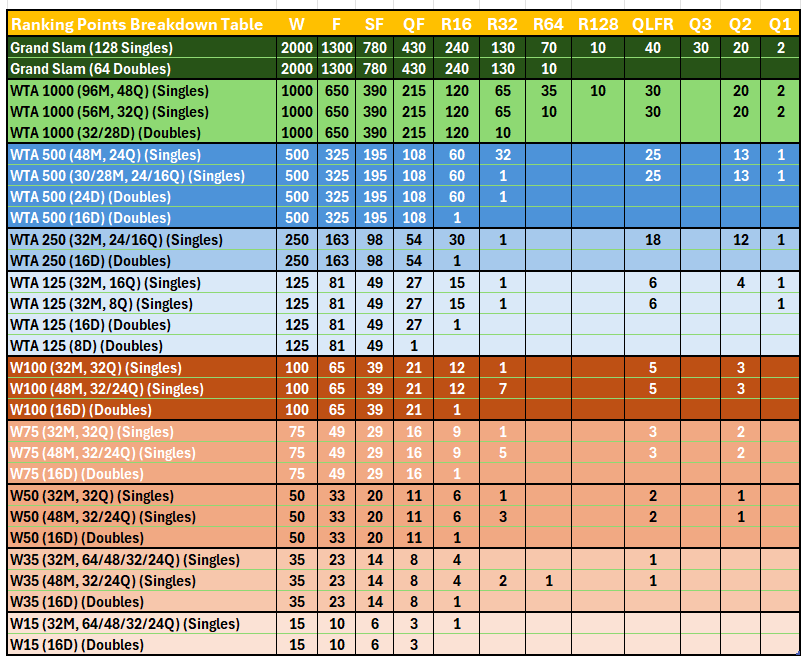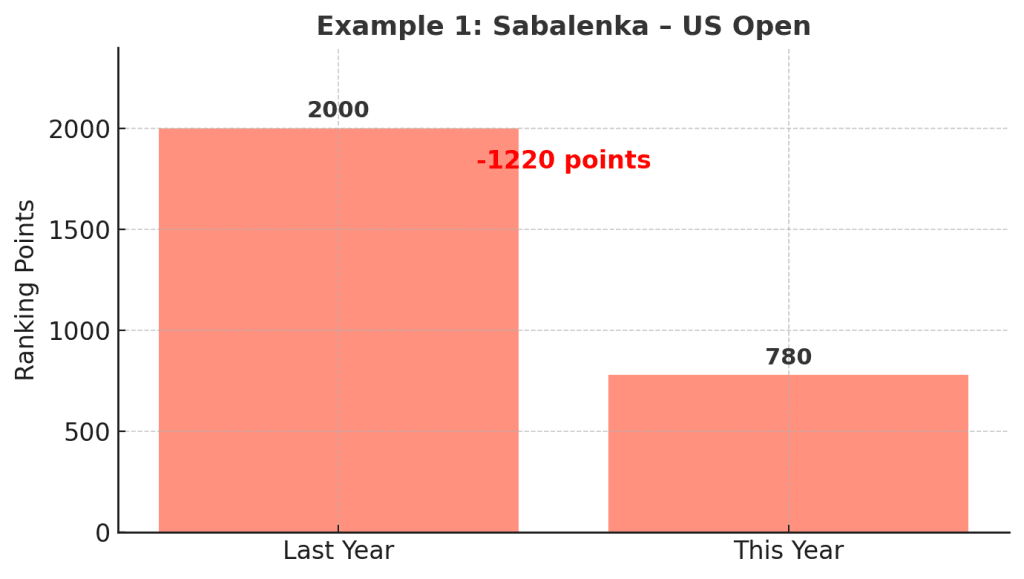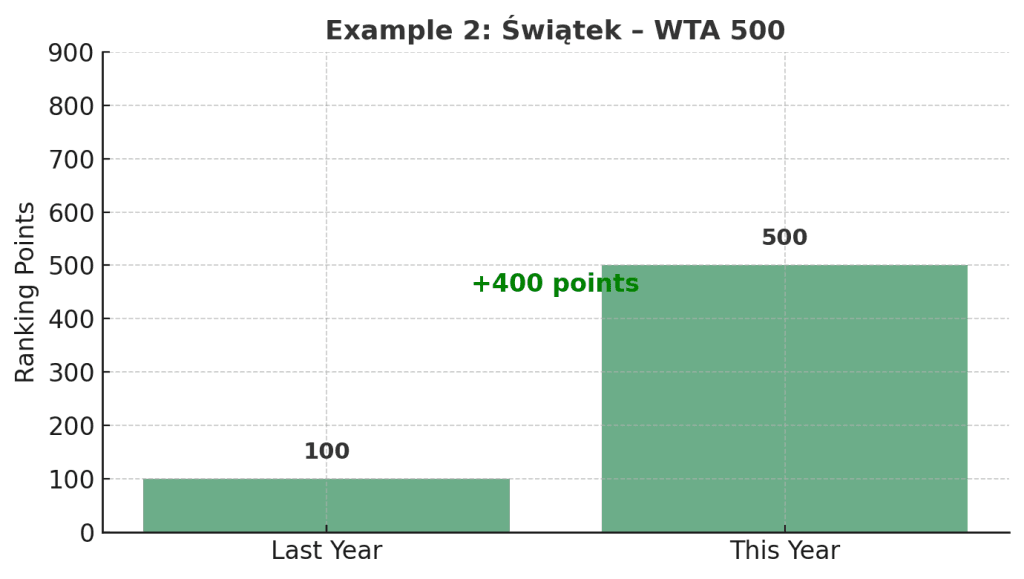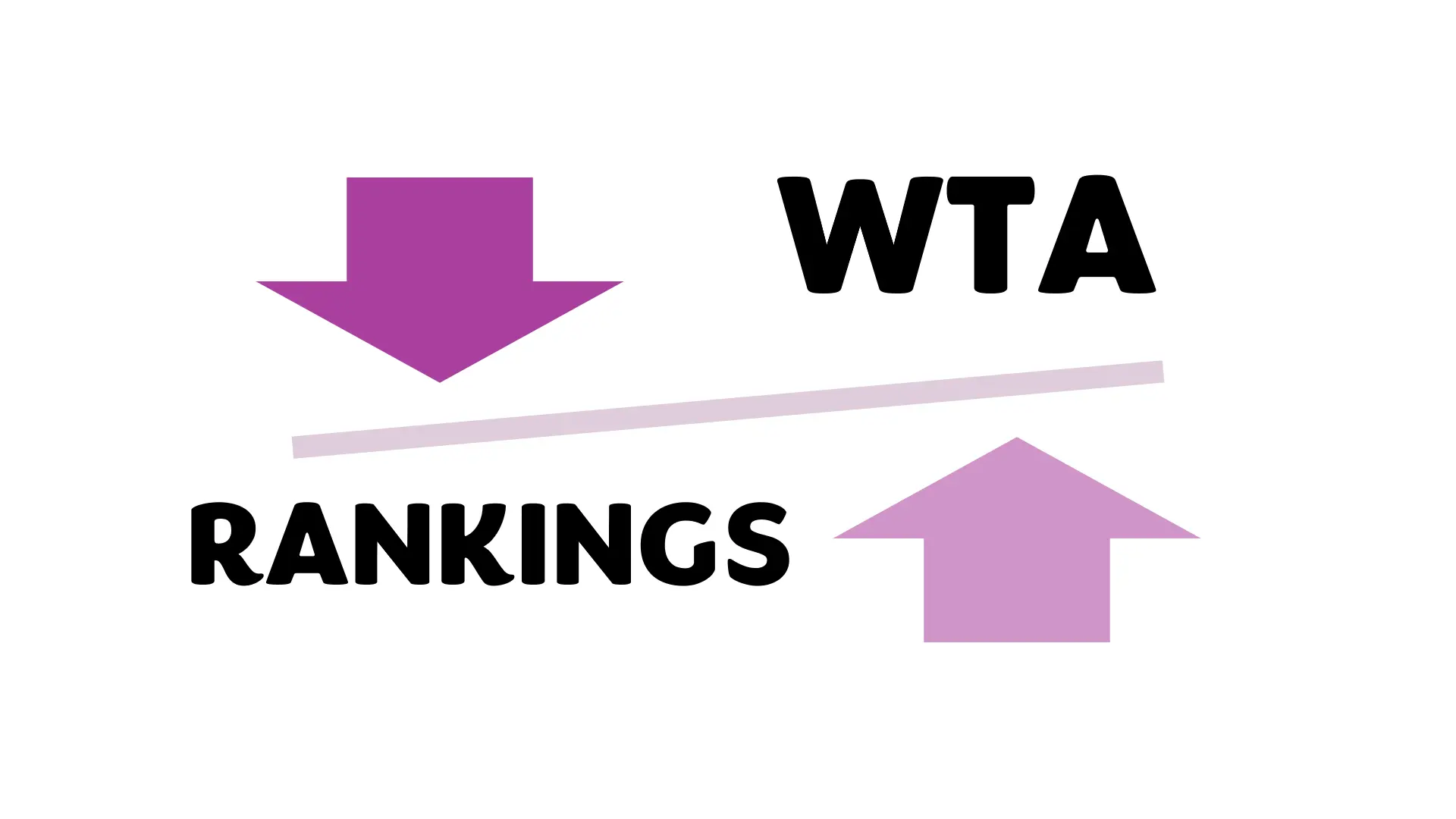Understanding how ranking points are awarded in women’s tennis is key for players, fans, and analysts alike. From the prestige of WTA Majors to the stepping stones of ITF W15 tournaments, this comprehensive breakdown covers everything you need to know. How often do we find ourselves wondering how many ranking points our favorite player has earned during a tournament? Bookmark this page for easy reference—it’s a must-have for anyone passionate about WTA tennis rankings!
All detailed explanations of the WTA rankings can be found in the second half of this article.
Ranking Points Breakdown Table

(Note: The table above is detailed and up-to-date. Below is a more general list that does not take into account the size of the main draw or qualifiers, but is good to have for a quick idea during Grand Slams.)
Grand Slam Tournaments (Majors)
- Winner: 2,000 points
- Finalist: 1,300 points
- Semifinalist: 780 points
- Quarterfinalist: 430 points
- Round of 16: 240 points
- Round of 32: 130 points
- Round of 64: 70 points
- Round of 128: 10 points
- Qualifier: 40 points
- Qualifying Round 3: 30 points
- Qualifying Round 2: 20 points
- Qualifying Round 1: 2 points
WTA 1000 Tournaments
- Winner: 1,000 points
- Finalist: 650 points
- Semifinalist: 390 points
- Quarterfinalist: 215 points
- Round of 16: 120 points
- Round of 32: 65 points
- Round of 64: 10 points
- Qualifier: 30 points
- Qualifying Round 2: 20 points
- Qualifying Round 1: 2 points
WTA 500 Tournaments
- Winner: 500 points
- Finalist: 300 points
- Semifinalist: 180 points
- Quarterfinalist: 100 points
- Round of 16: 55 points
- Round of 32: 30 points
- Qualifier: 25 points
- Qualifying Round 2: 18 points
- Qualifying Round 1: 1 point
WTA 250 Tournaments
- Winner: 250 points
- Finalist: 180 points
- Semifinalist: 110 points
- Quarterfinalist: 60 points
- Round of 16: 30 points
- Round of 32: 16 points
- Qualifier: 12 points
- Qualifying Round 2: 9 points
- Qualifying Round 1: 1 point
WTA 125 Tournaments (Challenger Women)
- Winner: 160 points
- Finalist: 95 points
- Semifinalist: 57 points
- Quarterfinalist: 29 points
- Round of 16: 15 points
- Round of 32: 8 points
- Qualifier: 6 points
- Qualifying Round 2: 4 points
- Qualifying Round 1: 1 point
ITF Women’s World Tennis Tour Tournaments
ITF W100
- Winner: 150 points
- Finalist: 90 points
- Semifinalist: 55 points
- Quarterfinalist: 28 points
- Round of 16: 14 points
- Round of 32: 7 points
- Round of 64: 1 point
- Qualifier: 6 points
- Qualifying Round 2: 4 points
ITF W80
- Winner: 130 points
- Finalist: 80 points
- Semifinalist: 48 points
- Quarterfinalist: 24 points
- Round of 16: 12 points
- Round of 32: 6 points
- Round of 64: 1 point
- Qualifier: 5 points
- Qualifying Round 2: 3 points
ITF W60
- Winner: 100 points
- Finalist: 60 points
- Semifinalist: 36 points
- Quarterfinalist: 18 points
- Round of 16: 9 points
- Round of 32: 5 points
- Round of 64: 1 point
- Qualifier: 5 points
- Qualifying Round 2: 3 points
ITF W25
- Winner: 78 points
- Finalist: 47 points
- Semifinalist: 28 points
- Quarterfinalist: 14 points
- Round of 16: 8 points
- Round of 32: 3 points
- Round of 64: 1 point
- Qualifier: 2 points
ITF W15
- Winner: 10 points
- Finalist: 6 points
- Semifinalist: 4 points
- Quarterfinalist: 2 points
- Round of 16: 1 point
- Qualifier: 1 point
The Basics: Winning = More Points
Every tournament on the WTA Tour offers ranking points. The deeper you go — from the first round to the final and ultimately the champion — the more points you collect. Bigger tournaments, like the Grand Slams, award far more points than smaller events.
Understanding this “point ladder” is essential because it explains why some results hardly move the rankings, while others can propel a player into the Top 10 overnight.
Tournament Levels: Why Size Matters
Think of WTA events as different levels in a video game. The higher the level, the more treasure (ranking points) at stake:
- Grand Slams (Australian Open, Roland Garros, Wimbledon, US Open): 2000 points for the winner. Even a single match win gives you a solid boost.
- WTA 1000s: Winners earn 1000–650 points, depending on the size. A quarterfinal can already mean 200+ points.
- WTA 500s: Champions get 500 points; quarterfinalists usually around 100.
- WTA 250s: Winners collect 250 points; quarterfinalists about 60.
- WTA 125s and ITF events: These are the entry levels, worth between 15 and 125 points for the champion.
The lesson is simple: big tournaments equal big rewards.
The 18-Best Rule: How Rankings Are Calculated
This is where precision matters. A player’s singles ranking is calculated from their best 18 tournaments over the past 52 weeks. Results outside of those 18 do not count.
This means two things:
- You cannot endlessly pile on points — only your top 18 results remain in play.
- Every new tournament is compared to the weakest tournament currently in your “Top 18.” If it’s better, it replaces that weaker result; if not, it doesn’t count at all.
Defending Points: Why Rankings Go Up or Down
Fans often hear that a player must “defend points” at a certain tournament. Here’s what that really means:
- If you did very well at a tournament last year, those points are set to “drop off” after 52 weeks.
- When you play the same event (or another event at the same time of year) this season, your new result is compared to what you are losing.
For example: If you made the semifinals in Monterrey in 2024 (185 points) but only reach the quarterfinals in 2025 (108 points), the live rankings don’t simply “add 108.” Instead, they compare 108 to the 185 you are losing. That leaves you with a net loss of 77 points.
And this isn’t limited to Monterrey. The same logic applies to any tournament. A player is always defending whichever tournament result is due to expire, and their new performance either matches, improves, or weakens that slot in their Top 18.
Why This System Matters
The 18-best structure explains why players sometimes win a match yet still drop in the live rankings. It’s not about whether they gained points in absolute terms, but whether their new performance was stronger or weaker than the one it replaced.
That’s why you’ll see live-ranking sites show gains or losses immediately — they calculate your updated total in real time, based on the rolling 52-week window.
Example 1: Aryna Sabalenka at the US Open
In 2024, Aryna Sabalenka won the US Open, which gave her 2000 ranking points. If in 2025 she would only have reached the semifinals, that is worth 780 points.
- Points earned in 2024: 2000
- Points earned in 2025: 780 (she won it again so zero points change)
- Net change: 780 replaces 2000 → –1220 points
So even though a semifinal is a deep run, compared to last year’s title defense it represents a huge drop. That explains why fans sometimes see “negative” totals even after a strong performance.

Example 2: Iga Swiatek at a WTA 500
Imagine Iga Swiatek played a WTA 500 tournament in 2024 and lost in the quarterfinals, which gave her 100 points. In 2025, at the same time of year but at a different WTA 500, she wins the title and collects 500 points.
- Points defended: 100
- Points earned: 500
- Net change: 500 replaces 100 → +400 points
Here, the win doesn’t just add 500 — it replaces the 100 points in her 18-best count, leading to a clear ranking rise beacuse of the 400 points extra.

Final Takeaway
The WTA rankings are not simply an “adding game.” They are a year-long cycle of defending, replacing, and upgrading results across 18 tournaments. Understanding this explains why some players rocket up the ladder while others, even after decent weeks, can slip down.
